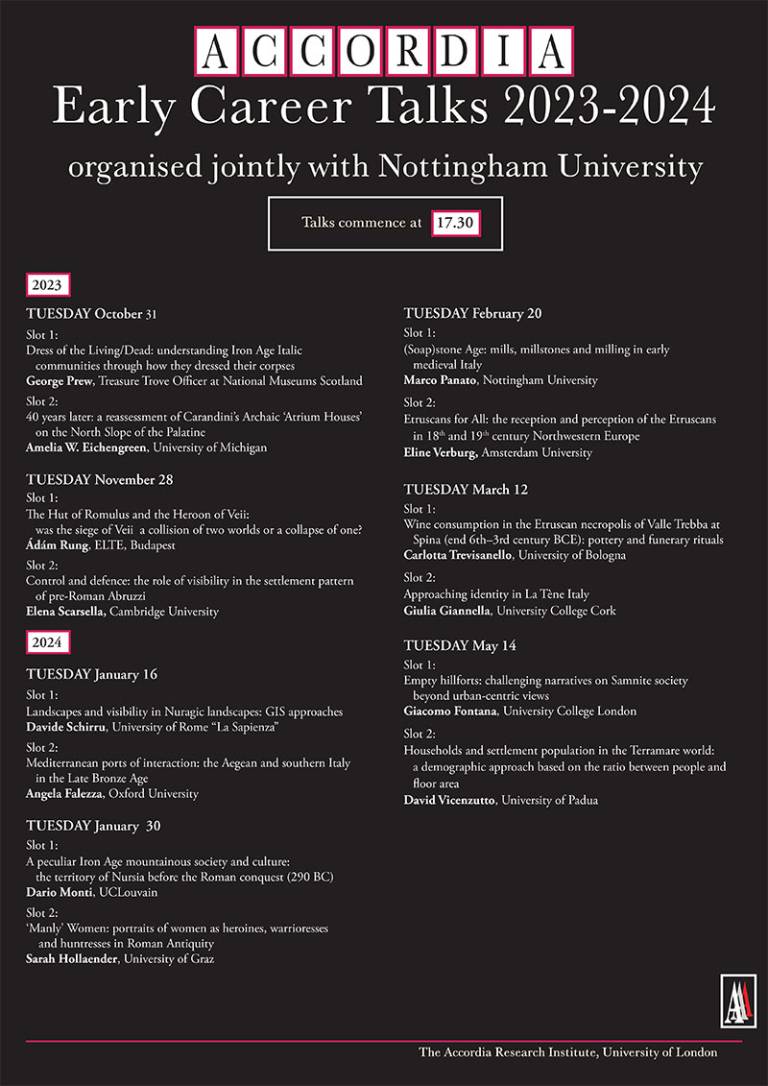Accordia Early Career Talks 2023-24: Session 2
28 November 2023, 5:30 pm–6:30 pm

A new series of Accordia Early Career Talks, organised jointly with Nottingham University, will be held online during 2023-24. The next in the series takes place on 28 November.
This event is free.
Event Information
Open to
- All
Availability
- Yes
Cost
- Free
Organiser
-
Prof Ruth Whitehouse
Talk 1: The Hut of Romulus and the Heroon of Veii: was the siege of Veii a collision of two worlds or a collapse of one? - Ádám Rung, ELTE, Budapest
The capture of Veii, by the legendary Camillus, is often thought of as one of Rome’s first steps towards both the glory of its later conquests and the complications brought about by its increasing wealth. But even in the main ancient source of this narrative, the fifth book of Livy’s history, the sack of Veii is something of a counterpart to the later sack of Rome itself by the Gauls, and that is only one of the ways in which the guilt complicating its glory is hinted at. From an archaeological point of view, early cultural contacts between the two towns are well-established, enough to suggest a possible early sense of kinship, predating, and at odds with, the “othering” of all Etruscans (as “Eastern” “Lydians”) in most classical sources. It still sounds striking, however, that ancient Veii might even have had a counterpart of one of the later symbols of Roman modesty, mentioned by Livy’s Camillus explicitly in contrast with Etruscan wealth: the Hut of Romulus. In this paper, I am arguing that a comparison of the early hut-like heroon excavated in Veii and the iconic memorial to Rome’s founder, known from Roman literature, might be fruitful in understanding both.
Talk 2: Control and defence: the role of visibility in the settlement pattern of of pre-Roman Abruzzi - Elena Scarsella, Cambridge University
During the Archaic period (mid 7th to mid 5th century BC), central Apennine was part of a larger network, connecting the Tyrrhenian and the Adriatic coasts of Italy. The mountains themselves were indeed the grand stage of a mosaic of interactions (not always peaceful) that eventually gave origin to the wide ethnic groups known from the classical literary tradition.
In this complex framework, the mountainous landscape of the Apennines plays a major role not only in defining territorial compounds but also in dictating necessities of defence and control of economic resources. Indeed, the harshness and the difficulties of a mountainous environment ensure a general scarcity of resources and it also creates the basis for a strong competition over the few exploitable land and resources. Hence, pivotal assets such as grazing land, mining ores and trade routes became the focus of an intricate system of hillforts and outposts that covers, visually and strategically, the entire Apennine route network.
In this talk, I will explore the settlement pattern of the pre-Roman Aterno Valley (Abruzzi) as a perfect example of capillary control of the landscape and its assets, through a widespread system of settlements based on intervisibility and interconnection. I will also consider them in the wider context of a defence system of borders within the area, on a medium scale and I will relate it to the formative process of the Vestini people.
All talks will commence at 5.30pm. Abstracts and Zoom links will be circulated nearer the time. If you would like to receive these (and are not on the Institute's events list), please contact Ruth Whitehouse (accresearch20@gmail.com).
Programme | Accordia Early Career Lectures 2023-24
- 31 October 2023: Dress of the Living/Dead: understanding Iron Age Italic communities through how they dressed their corpses - George Prew, National Museums Scotland / 40 years later: a reassessment of Carandini’s Archaic ‘Atrium Houses’ on the North Slope of the Palatine - Amelia W. Eichengreen, University of Michigan
- 28 November 2023: The Hut of Romulus and the Heroon of Veii: was the siege of Veii a collision of two worlds or a collapse of one? - Ádám Rung, ELTE, Budapest / Control and defence: the role of visibility in the settlement pattern of of pre-Roman Abruzzi - Elena Scarsella, Cambridge University
- 16 January 2024: Landscapes and visibility in Nuragic landscapes: GIS approaches - Davide Schirru, University of Rome “La Sapienza" / Mediterranean ports of interaction: the Aegean and southern Italy in the Late Bronze Age - Angela Falezza, Oxford University
- 30 January 2024: A peculiar Iron Age mountainous society and culture: the territory of Nursia before the Roman conquest (290 BC) - Dario Monti, UCLouvain / ‘Manly’ Women: portraits of women as heroines, warrioresses and huntresses in Roman Antiquity - Sarah Hollaender, University of Graz
- 20 February 2024: (Soap)stone Age: mills, millstones and milling in early medieval Italy - Marco Panato, Nottingham University / Etruscans for All: the reception and perception of the Etruscans in 18th and 19th century Northwestern Europe - Eline Verburg, Amsterdam University
- 12 March 2024: Wine consumption in the Etruscan necropolis of Valle Trebba at Spina (end 6th – 3rd century BCE): pottery and funerary rituals - Carlotta Trevisanello, University of Bologna / Approaching identity in La Tène Italy - Giulia Giannella, University College Cork
- 14 May 2024: Empty hillforts: challenging narratives on Samnite society beyond urban-centric views - Giacomo Fontana, UCL Institute of Archaeology / Households and settlement population in the Terramare world: a demographic approach based on the ratio between people and floor area - David Vicenzutto, University of Padua
 Close
Close

